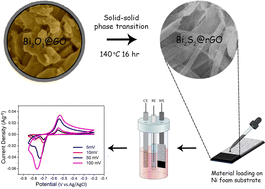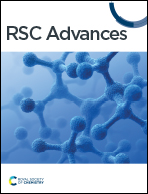Solid state engineering of Bi2S3/rGO nanostrips: an excellent electrode material for energy storage applications†
Abstract
The study presents a novel, one-pot, and scalable solid-state reaction scheme to prepare bismuth sulphide (Bi2S3)-reduced graphene oxide (rGO) nanocomposites using bismuth oxide (Bi2O3), thiourea (TU), and graphene oxide (GO) as starting materials for energy storage applications. The impact of GO loading concentration on the electrochemical performance of the nanocomposites was investigated. The reaction follows a diffusion substitution pathway, gradually transforming Bi2O3 powder into Bi2S3 nanostrips, concurrently converting GO into rGO. Enhanced specific capacitances were observed across all nanocomposite samples, with the Bi2S3@0.2rGO exhibiting the highest specific capacitance of 705 F g−1 at a current density of 1 A g−1 and maintaining a capacitance retention of 82% after 1000 cycles. The superior specific capacitance is attributed to the excellent homogeneity and synergistic relation between rGO and Bi2S3 nanostrips. This methodology holds promise for extending the synthesis of other chalcogenides-rGO nanocomposites.



 Please wait while we load your content...
Please wait while we load your content...